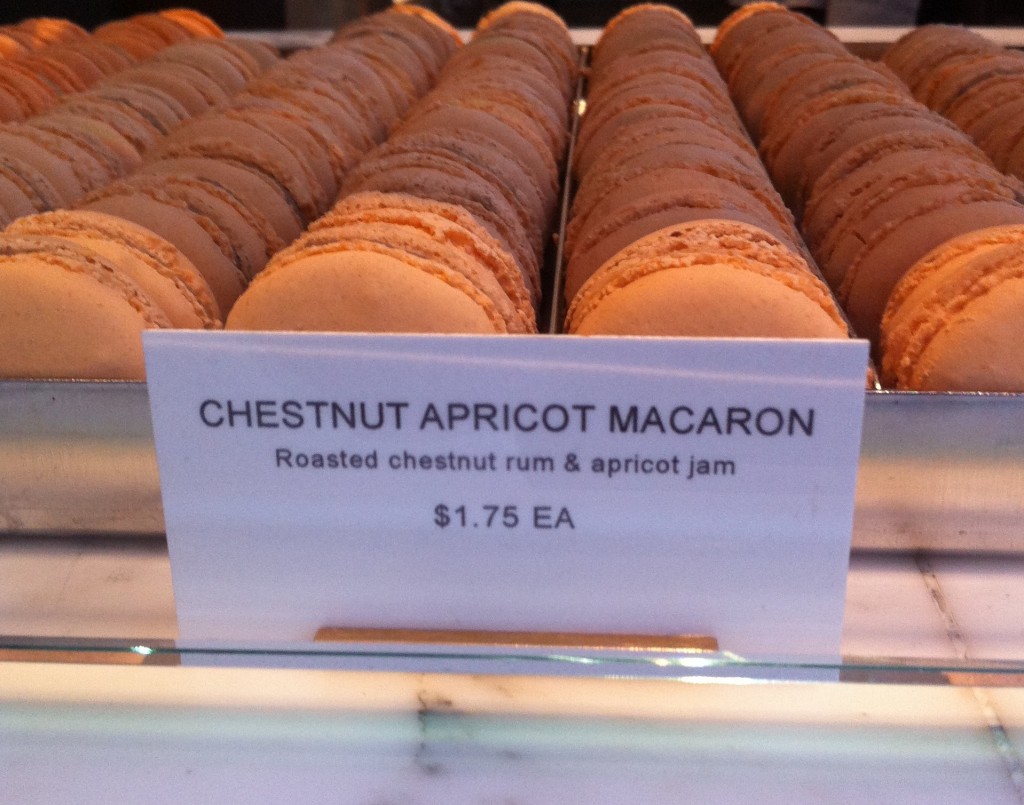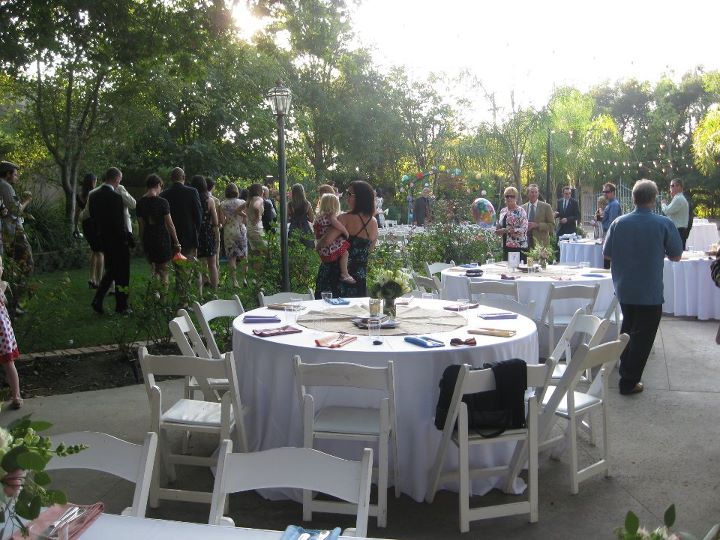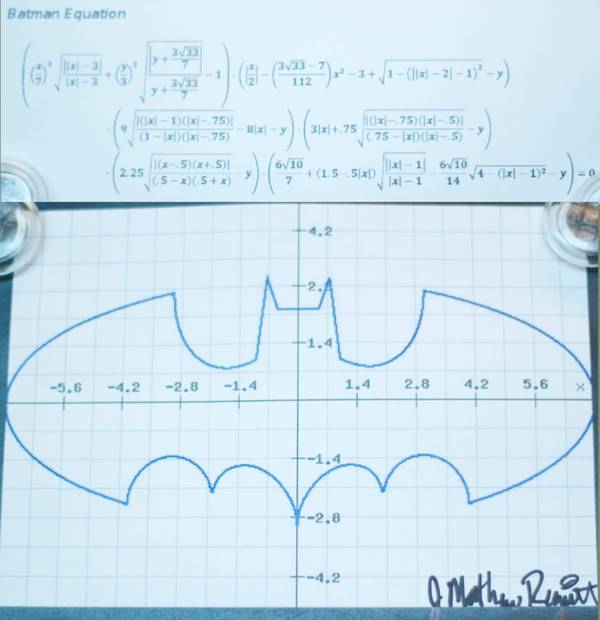Math of Macarons
A few weeks ago, I was downtown with the missus when we stumbled upon the Bottega Louie Restaurant and Gourmet Market. The window display was enticing, so we went inside and discovered, among other things, a bakery. This one's focus was the macaron, one of many sweets aiming to topple the cupcake as the trendiest dessert, and so for a town obsessed with the current trends, it is no surprise that Los Angeles is home to several similarly specialized patisseries.
Though smaller than the average cupcake, the macaron is also more labor-intensive, and is therefore frequently on the more expensive end of the confectionery spectrum. The macarons at Bottega Louie, for example, will run you $1.75 each.

One of many delightful flavors.
If you need a sweet fix, though, a single macaron may not be enough. Anticipating such a first-world problem, Bottega Louie also offers boxes of macarons for purchase. The boxes come in three sizes: the small holds five macarons, the medium holds thirteen...
Math + Halloween, Part 4
It's that time of year again. If you are looking for some math-themed costume ideas, then look no further. Though it gets harder to keep this tradition with each passing year, here are a few ideas is you're looking to rock that mathematical look at whatever event you are planning to attend during this frightful Halloween season. Ideas from previous years can be found here, here, and here.
Without further ado, let's begin!
1. Tony Stark
Yes, yes, I know - since Iron Man hit the screens in the summer of 2008, the titular character has become a popular costume idea, joining the ranks of comic book icons like Superman and Spiderman. I'm not talking about dressing up as Iron Man, though. Instead, I am recommending a costume based on the man inside the suit - Tony Stark, playboy billionaire and (more importantly) mathematical wünderkind. All you really need is some delicately coiffed facial hair and a glowing circle on your chest. Aside from that, the world is really your oyster...
A Mathematics Community
Whether knowingly or not, NBC Thursday night comedies have made occasional dalliances with mathematics. For example, you can see here for a mathematical discussion inspired by The Office, and here for one inspired by Parks and Recreation.
Today I would like to add to this esteemed list the show Community, now in its third season on NBC's Thursday block. As the title indicates, the show centers around a group of friends who are students at the fictional Greendale Community College (how this formula will pan out if the show lasts more than four seasons is uncertain).
In a recent episode (titled Competitive Ecology), the gang divides themselves up into pairs of lab partners for Biology class, but they quickly discover their pairings are less than ideal - especially since, with an odd number in the central crew, one member must pair up with someone who is not in their clique. Their first assignment is to build a terrarium, and with the deadline quickly approaching, they need to find...
Playoff Probabilities
Continuing with last week's theme, and since we are in the midst of playoffs, I'd like to take a moment now to discuss another link between baseball and mathematics. This link is particularly timely since the scuttlebutt on the internet suggests that next year the playoff rules for baseball will be changed: the number of teams competing for the World Series will increase from 8 to 10, and because of that, another round of playoff games will be introduced.
Currently, the playoffs consist of three rounds. The first round is the Division Series, in which eight teams compete in a best-of-five match-up (equivalently, a first-to-three match-up, i.e. the first team to win three games wins the series). The second and third rounds, better known as the Championship Series and World Series, are composed of four and two teams, respectively, but are both best-of-seven (equivalently, first-to-four). Because of these three rounds of several games each, the playoff season is already quite long...
Moneyball
This weekend, mathematics played a supporting role to Brad Pitt in one of fall's first critical darlings, Moneyball. Based on the Michael Lewis book of the same name, the film profiles the Oakland A's during their 2002 bid for World Series glory. What allegedly separates their story from the story of other teams during that season is the way General Manager Billy Beane, played by Brad Pitt, deals with the budget constraints imposed on him by the team's owners.
With a payroll roughly a third the size of the Yankees', Beane understood that the playing field was not a level one from an economic standpoint. What's more, at the end of the 2001 season, three of the A's star players left Oakland for bigger paychecks. To fill the void, the film (and book) show how Beane took a more analytic approach, and used statistical analysis to uncover players who were undervalued and could be purchased for much less than they were worth. Beane, together with Paul DePodesta (Peter Brand in the film...
Wedding Mathematics, Part 3
Today I would like to wrap up my series on mathematics and weddings (a series begun here and continued here) with a little advice for soon-to-be brides and grooms who are looking to integrate some math into their celebrations. If this describes you, then congratulations - not only on your upcoming nuptials, but also on the classy way you are looking to celebrate them.
For our own wedding, my bride and I decided it would be natural to incorporate some mathematics into the table numbers. There is some freedom in how one decides to do this. For example, we initially toyed with the idea of using numbers for the tables that were somehow significant to us and our relationship, but found it too difficult to come up with examples meeting this criterion. If one wants intrinsically interesting numbers, there are many examples among the whole numbers (I was particularly fond of using the smallest whole number expressible as the sum of cubes in two different ways). In the end, though, we decided...
Wedding Planning and the Ménage Problem
Last month I wrote a wedding-themed post on some statistics behind the show Four Weddings. Now, fully refreshed from my own two week honeymoon, I would like to take some time to discuss some other areas of intersection between weddings and mathematics.
One of the things I most looked forward to during the planning of our wedding was the determination of the seating chart. Searching for an optimal arrangement given peoples' preferences to sit next to their friends and away from their enemies was a fun little challenge. In the end, though, perhaps I made things too easy on myself. Although I assigned people to specific tables, I did not assign seats within the tables themselves. Instead, people were free to sit however they chose once they found their table.

An example of our seating. Hat tip to Dave Gilbert for the shot!
Were I truly a glutton for punishment, I would have assigned seats at each table. And were I a traditionalist, I would have arranged the seating so that couples...
Four Weddings and Some Statistics
(Update, March 2018: I've rewritten this post on my new site. The rewrite includes new data, as well as more interactive visualizations. You can check it out here!)
When my fiancee was in the midst of the wedding planning, part of her research (or perhaps it was simply a guilty pleasure) involved watching wedding shows on basic cable. For those of you who have not had the pleasure, between stations like WE tv and TLC, there are no fewer than nine different wedding-themed reality shows airing weekly. Many of them are appealing in a rubbernecking sort of way; much like a car crash, the spectacle is too ridiculous to turn away from (I'm looking at you, My Big Fat Gypsy Wedding).
Of all of these shows, though, the one that most piques my mathematical interest is TLC's Four Weddings. Based on a British show with the same name, the premise is as follows: four brides-to-be, unknown to one another, meet and attend each others' weddings. When one bride gets married, the other three...
Batman Interlude
Hi everyone. Apologies for flying under the radar lately. I am getting married soon, and along with life's usual habit of getting in the way, preparations are surprisingly time consuming.
Having said that, I have a couple of articles in the pipeline specifically addressing the intersection of mathematics and weddings (the intersection is non-empty, I assure you). In the meantime, if you're looking for a mathematical fix, you need look no further than this link, which gives an explicit function whose graph bears a striking resemblance to the Batman logo. Mathematicians who need to contact crime fighters need no longer live in fear.

Na-na-na-na Na-na-na-na MATH GRAPHS!!!!
Want to see your favorite superhero's logo memorialized in the Cartesian coordinate plane? Give it a shot!
I'll be back soon with some more substantial content. Hat tip to Nate for the link to this crime-reducing function.
Math Jams
Sorry I'm so late to the party on this one, but I wanted to draw your attention to this NPR article from a couple of months back. It profiles the "Songwriter in Residence" program at the University of Tennessee's National Institute for Mathematical and Biological Synthesis (or NIMBioS if you feel like spitting a bunch of letters out of your mouth). The experimental program hires songwriters for one month stints at the Institute, during which time they work with researchers to develop two songs on current scientific/mathematical research. Here's one of the resident's performing a song on sexual selection:
While combining the arts with the sciences is nothing new, it's cool to see a program embrace the intersection of these disciplines with such gusto. Of course, it can be difficult to squeeze educational content out of a song with a science focus, but if School House Rock has taught me anything, it is that education and fly jams need not be mutually exclusive. If you feel, however...
Page 6 of 20

